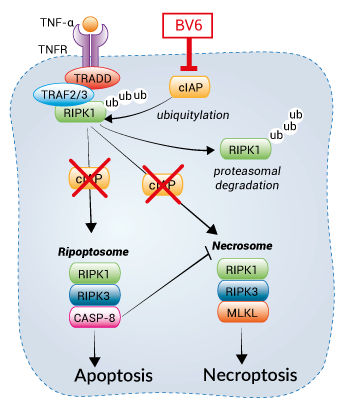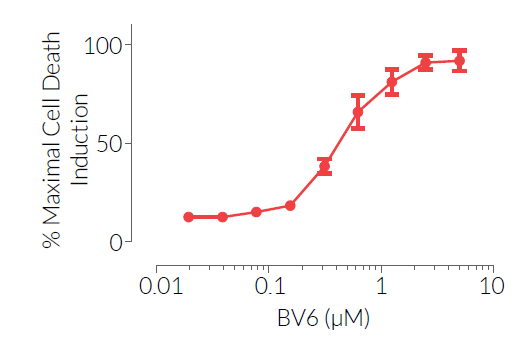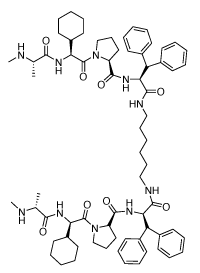IAP inhibitor - BV6
| Product | Unit size | Cat. code | Docs. | Qty. | Price | |
|---|---|---|---|---|---|---|
|
BV6 Inhibitor of IAPs - Smac mimetic - InvitroFit™ |
Show product |
5 mg |
inh-bv6
|
|
Antagonist of IAPs

Activation of RIPK1-mediated cell death using BV6
BV6 is a potent and specific antagonist of at least three inhibitors of apoptosis proteins (IAPs), namely cIAP1, cIAP2, and XIAP [1]. IAPs exert their anti-apoptotic actions through ubiquitylation of RIPK1 (receptor-interacting serine/threonine-protein kinase 1 ), which results in RIPK1 proteasomal degradation [2]. RIPK1 can no longer recruit RIPK3 and MLKL to form the necrosome and promote necroptosis upon engagement of death receptors.
![]() Learn more on apoptosis and necroptosis
Learn more on apoptosis and necroptosis
Mode of action:
BV6 acts as a Smac mimetic. Smac/DIABLO (second mitochondria-derived activator of caspases/direct IAP-binding protein with low isoelectric point) is a natural antagonist of IAPs, which is released in the cytosol in response to pro-apoptotic stimuli. Upon binding to cIAP, BV6 induces its ubiquitination and rapid proteasomal degradation, enabling the deubiquitination of RIPK1. Thus, BV6 acts as an inducer of apoptosis and necroptosis initiated by death signals such as TNF-α [1, 3].
Note: For full induction of necroptosis upon death receptor engagement, blockade of CASP-8 is also required [4]. This can be achieved by using the CASP-8 inhibitor, Z-IETD-FMK.
Key features:
- Potent and selective inhibitor of cIAP1, cIAP2, and XIAP
- Allows RIPK1-mediated apoptosis or necroptosis
- InvitroFit™ grade: each lot is highly pure (≥95%) and functionally tested
References
1. Varfolomeev E. et al., 2007. IAP antagonists induce autoubiquitination of c-IAPs, NF-kB Activation, and TNFα-dependent apoptosis. Cell. 131(4):669-681.
2. Annibaldi A. et al., 2018. Ubiquitin-mediated regulation of RIPK1 kinase activity independent of IKK and MK2. Molecular Cell. 69:566-580.
3. Li W. et al., 2011. BV6, an IAP antagonist, activates apoptosis and enhances radiosensitization of non-small cell lung carcinoma in vitro. J. Thorac. Oncol. 6(11), 1801-1809.
4. Choi M.E. et al., 2019. Necroptosis: a crucial pathogenic mediator of human disease. JCI Insight. 4(15):e128834.
Specifications
CAS number: 1001600-56-1
Synonyms: BV-6; N,N’-(hexane-1,6-diyl)bis(1-{(2S)-2-cyclohexyl-2-[(N-methyl-L-alanyl)amino]acetyl}-L-prolyl-beta-phenyl-L-phenylalaninamide)
Working concentration: 1-20 µM for cell culture assays
Solubility: 6 mg/ml (5 mM) in DMSO
Formula: C70H96N10O8
Molecular weight: 1205.6 g/mol
Quality control:
- Purity: ≥95% (UHPLC)
- The inhibitory activity of the product has been validated using in-house cellular assays with THP1-HMGB1-Lucia™ cells.
- The absence of bacterial contamination (e.g. lipoproteins and endotoxins) has been confirmed using HEK-Blue™ TLR2 and HEK-Blue™ TLR4 cells.
Contents
- 5 mg BV6 (provided as a powder)
![]() BV6 is shipped at room temperature.
BV6 is shipped at room temperature.
![]() Upon receipt, store at -20 °C.
Upon receipt, store at -20 °C.
![]() Resuspended product is stable for at least 6 months when properly stored.
Resuspended product is stable for at least 6 months when properly stored.
![]() Avoid repeated freeze-thaw cycles.
Avoid repeated freeze-thaw cycles.







